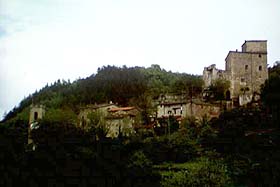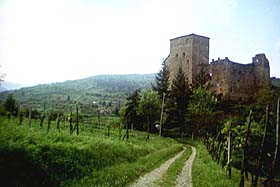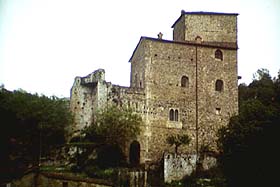Castel S.Niccolò
 |
 |
| The castle with the country seen from the bridge on the stream Solano. | View from the southern side. |
Castel S.Niccolò dominates the modern suburb of Strada in Casentino reachable from the SS70 Umbro-Casentinese following the well signaled alternative from which is only few kilometers far.
The ancient castle of S.Niccolò, already known as 'Court of Vado', rises on from a high hill from which it dominates the valley of the stream Solano, which enters the Arno after few kilometers into the plain of Campaldino. The Castle, is first mentioned in documents of the year 1029. It was one of the strongest fortresses of the counts Guidi from Battifolle and its history is strongly tied up with that of this powerful feudal family. Since 1212 the gentleman of the castle was Count Guglielmo Novello who was succeeded by his child Galeoto who brought tyranny and cruelty. In 1349 the people along with those living near the castles, including Montemignaio, revolted. Once taking possession of Castel S.Niccolò the inhabitants were subdued by the Florentine Republic which made the place the chief town of the new called 'Mountain Fiorentina' Podesteria, born from the union with Montemignaio and Battifolle. In 1440 the castle vainly attempted to withstand the siege of troops commanded by Niccolò Piccinino united with those of the last counts of Guidi di Poppi. The cruelty of this long siege has remained in the history: whoever tried to leave Castel S.Niccolò was captured and launched by the catapults back into to castle creating mayhem. Once conquered in an act of revenge all the inhabitants were hung along the curtain walls. After these bloody actions the Florentine Republic dismantled all the castles of the Casentino.
 |
|
The Palace with the high tower of the keep.
|
The analysis of Castel S.Niccolò has to begin with the lower part, the stone bridge (destroyed during the last war but reconstructed in to its original form) that crosses the stream Solano. Just the existence of this ford gave origin to the castle. This is constituted by three elements: in the most elevated position on the knoll of the fortress, the gentleman's residence, linked at its base a group of houses, among which is the church, encircled by walls with a gate, defended by a tower, opened in correspondence of the only road connecting with the bottom of the valley and, to the foot of the hill, in correspondence of the bridge, another group of houses with the function of 'mercatale' (Market) from which originated the town of Strada in Casentino. The most important parts is the fortified palace that was residence of the counts of the Guidi family first and later the Florentine Podestà (medieval term for chief magistrate or governor) endowed with a two windows and a beautiful Gothic portal and the high mighty keep. The castle is for large part intact, even if in the western front the external walls are gone. Entering the inner ward we can admire an elegant gallery, the cistern and the reconstructed wall walk on the east side, in some points still endowed with battlements. Also well preserved is the southeast tower, open on the side facing the courtyard, and a twin to the other at the angles of the enclosure which no longer exist. In the wall that connects the tower to the keep is a postern. What we see is due to the patient work of restoration undertaken by the owners, thay have freed the historical vestiges from modern additions of the last years bringing them to the ancient shine. The eastern side of the castle with the keep on the left and the intact curtains that encircle it up to the southeast tower is perhaps the most powerful image between those of all the castles of the Casentino area. The castle is a private residence visitable only on prenotation.
| More Photos |
| Back to Homepage |
| Back to Castles Index |